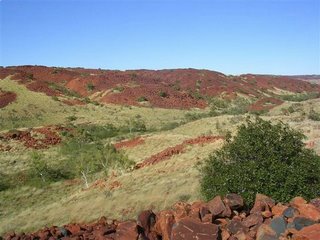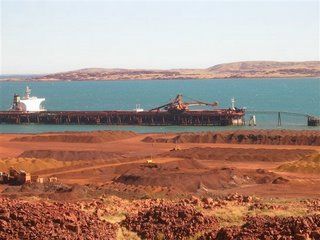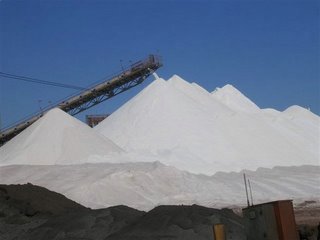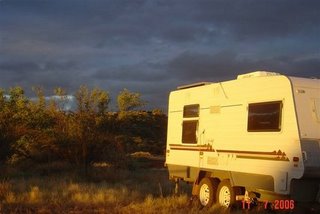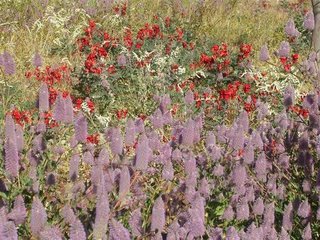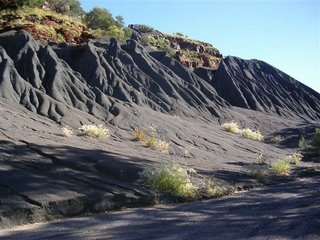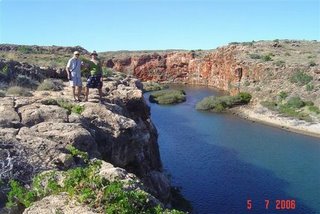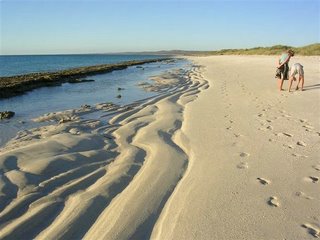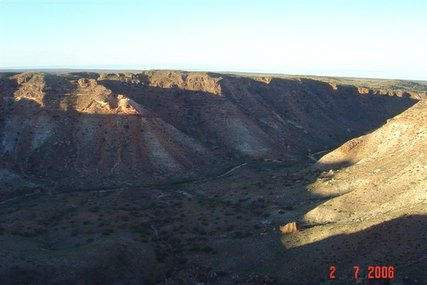
Railway bridge over de Grey river
It was “back to the seaside” for us this week and little else than one lazy, sun-filled day following another exploring the coastline between Cape Keraudren and Eighty Mile Beach – both locations lying well south of Broome and in a section of the coast where the tidal range is becoming large, i.e. in the order of 5 - 7m.
The campsite at Cape Keraudren is run by the Shire of East Pardoo.
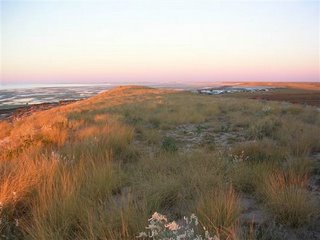
Other than a bush toilet, used by one fellow to post a notice about his availability as an IT expert, there are no facilities. No fresh water and no fire wood – just a few dunes, rugged limestone platforms at the water’s edge and the bluest of blue seas stretching as far as the eye can see. Most folk who camp there, for periods up to three months, rely on the Pardoo roadhouse, 14km back along a dusty corrugated track to the main road, for their supplies. They not only do their laundry at the roadhouse but also use the phone; get their post, vegetables and groceries delivered there and use it to re-supply with water & fuel.
We parked Getaway in a bus terminus! Actually a group of nomads all using buses, some the size of luxury Greyhound coaches, as their chosen mode of travel. Behind a few, a trailer can be found to transport their runabout car, as well as a boat. They carry 600 litres of fuel on board and 44 gallon drums full of water, not to mention the dog (or dogs) and, in one case, the cat as well! They are serious nomads these folk, making our little rig look positively miniscule by comparison!
Our days at Cape Keraudren were filled by much idleness, walking along the beach looking for shells, reading and sleeping. However, at low tide we sprung into action and spent many a happy hour wandering over the vast expanse of flat rocky platforms, capped by fine sand that lay in front of us, peering at the weird variety of creatures exposed in the rock pools, many of which we had never seen before; rude squirts shooting water up our legs when we least expected. Not to mention lots of sea-anemones closing up in a fashion similar to lights going out across a city as we stepped across them semi-buried in the sand. We found an octopus trying to maintain a low profile within a shallow sand pool, razor shells and sponges – one even making a good beanie for Lea.

Lea's sponge hat
Close by was a mangrove creek in which we could hear the squabbling of roosting fruit bats and found evidence of mass mortality of small fish & prawns on the floor of the channel. They must have been stranded in the pools formed on the last spring tide and, as in the case of “the last feast of the crocodiles”, died as the pools gradually dried up. Now that we are this far north it is interesting to see how many elements of the Northern Territory fauna are gradually becoming apparent – not only fruit bats but also friar birds, various parrots, barramundi and warnings about crocodiles. We had magnificent views of the tidal flats, with gnarled old mangroves on the edge and ornately sculptured, oyster clad rocks. At one point we found the tail of a reptile still actively wriggling on the ground that had either been shed, or severed, after capture by a bird of prey. After searching through our book back in the truck, we decided it must have been that of a legless lizard (lerista). By the end of that evening walk Lea was decidedly twitchy after finding another two dead “snakes” (lerista) and a dark brown snake crossed our path. That one, too quick to identify!
The Caravan Park at Eighty Mile Beach was our next stay where the white expanse of sand stretching as far as the eye can see is an unbelievable sight.

Low tide at Eighty Mile beach
The beach is probably the best part of 700m wide at low tide; flat as a pancake and composed of finely packed sand on the surface of which are masses of shells. We walked out at low tide stepping over the small crabs that, on our approach, bury themselves in an instance; picking up shells (sand dollars) and wandering aimlessly over the incredible expanse of wet, gradually draining sand which, as you can imagine, is an absolute spectacle as the sun goes down. Our food stocks are running out, particularly fruit, veg and bread, but we are in no hurry to rush so making “do” with dry goods.
En route to the Port Smith caravan park we enjoyed watching a black-headed python crossing the road. However, the park was not on the coast as we had expected, but 500m away from a “lagoon” – a mangrove dominated inlet which we walked to in the afternoon while the tide was going out, the floor of the swamp covered by masses of small black & white molluscs. On the way back to the park Lea found a can full of beer – Emu Export – lying on the road It served as the basis of our shandy that evening. This caravan park was most definitely a fisherman’s haunt. Not somewhere we would return to in a hurry yet we found pleasure in the crested pigeons, the friar birds calling amongst the trees and some captive wallabies in an enclosure right next to our site.
We thought we’d completed our second blog in Port Smith, in readiness to send off the two from Broome on Monday bringing us up to date again. However, on the dirt road from Port Smith we were waved down by a passing rig and told fuel or liquid was pouring out behind us. Turned out the tap on our water tank had shaken loose. This adds another thing to be rectified in Broome along with the repairs to be made to our fridge and awning as well as having the deep cycle batteries realigned that Getaway has been booked in for. Big “shop up” required before we tackle the Kimberley region and Skiv needs to refuel and be serviced. Sometime in the coming week we will be losing Paula who has been on the road with us for the last six weeks. From Broome she will be trying to sort out a way to return to her home on the Gold Coast.
